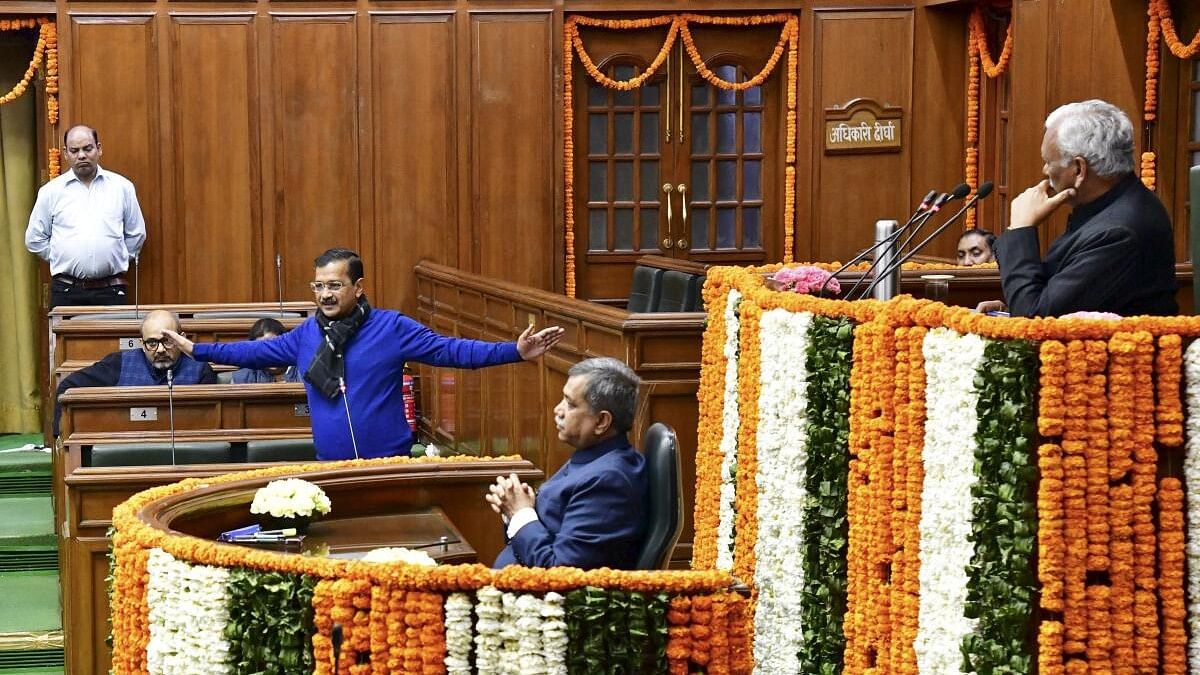
In this file image, Arvind Kejriwal speaks during confidence motion in New Delhi Assembly.
Credit: PTI Photo
With Delhi Chief Minister Arvind Kejriwal behind the bars, his earlier statement of Delhi elections being fought on the vexed issue of 'full statehood' for Delhi carries more weightage now.
The Kejriwal government, who has been at the helm for almost a decade has had numerous run-ins with Lieutenant Governors (LG), who are political appointees and just carry out the orders of whoever is in power at the Centre.
It is against this backdrop that the Aam Aadmi Party (AAP) has promised to give Delhi full statehood in its election manifesto. That will literally free the administration from the clutches of the LGs who more often play His Mater’s Voice game.
Viewed in the context of the CM vs LG stand off, this is the right time to look back at the chequered history of Delhi’s statehood and the numerous administrative tussles that have followed.
The Beginning
Delhi, the erstwhile capital of British India, has always been in the limelight due to the tussle over its administration. Following the Sepoy Mutiny, British rulers were forced to look for a new capital and according to a report in The New Indian Express, Delhi was chosen as the new capital for multiple reasons which included the centrality and connectivity of the place.
Once Delhi became the national capital, the Colonial government, through various Acts made it a chief commissioner’s province, which resembles more or less the present-day Union Territory.
Independent India
Post Independence, Delhi retained its identity as the national capital, but after much acrimony. In 1951, Delhi’s status was changed when a Legislative Assembly came into force. However, subjects such as public order, police, land, and municipality were left with the central government.
A year later, Delhi got is first chief minister in Chaudhary Brahm Prakash from the Indian National Congress.
Constitution Amendment
With the State Reorganisation Act passed in 1956, the post of chief minister was abolished and it took almost 37 years to get it reinstated.
As per the State Reorganisation Act, the States were governed by a council of ministers appointed through elected representatives from the Legislative Assemblies while Delhi, just like other Union Territories, had an Administrator appointed by the President to run the show.
Later in 1966, the Delhi Administration Act, 1966 was passed which provided it with limited representative government through metropolitan Council, comprising 56 elected members and five nominated members.
Balakrishnan Commission Report
In 1987, the Balakrishna Committee on the Reorganisation of Delhi Administrative Set Up, was set up. In its findings released in 1989, the committee recommended that Delhi cannot be given full statehood as it is the Federal Capital and recommended that it should remain a Union Territory.
Elections were held two years later with Madan Lal Khurana becoming the first BJP Chief Minister of the state. However, administrative tussles continued especially regarding the extent of power which the LG was holding.
It reached a flash point when Narendra Modi-led BJP came to power in 2014 and had a nominee of their choice at the Centre to spell trouble in Delhi where Kejriwal was at the helm and since the standoff has continued.
The major bone of contention in the current AAP government vs LG stand off is the Supreme Court judgement that Delhi was not a full state and hence, unlike other state governors, Delhi's LG was not just a mere constitutional figurehead, but also bore the title of administrator.
The standoff has continued and with Kejriwal too behind the bars, it remains to be seen how this vexed issue is going to be resolved.